7 Smart Rings - Unique Comparison
Seven rings and two hands. A unique comparison of smart rings. Cycling, sleep, daily insights and more!
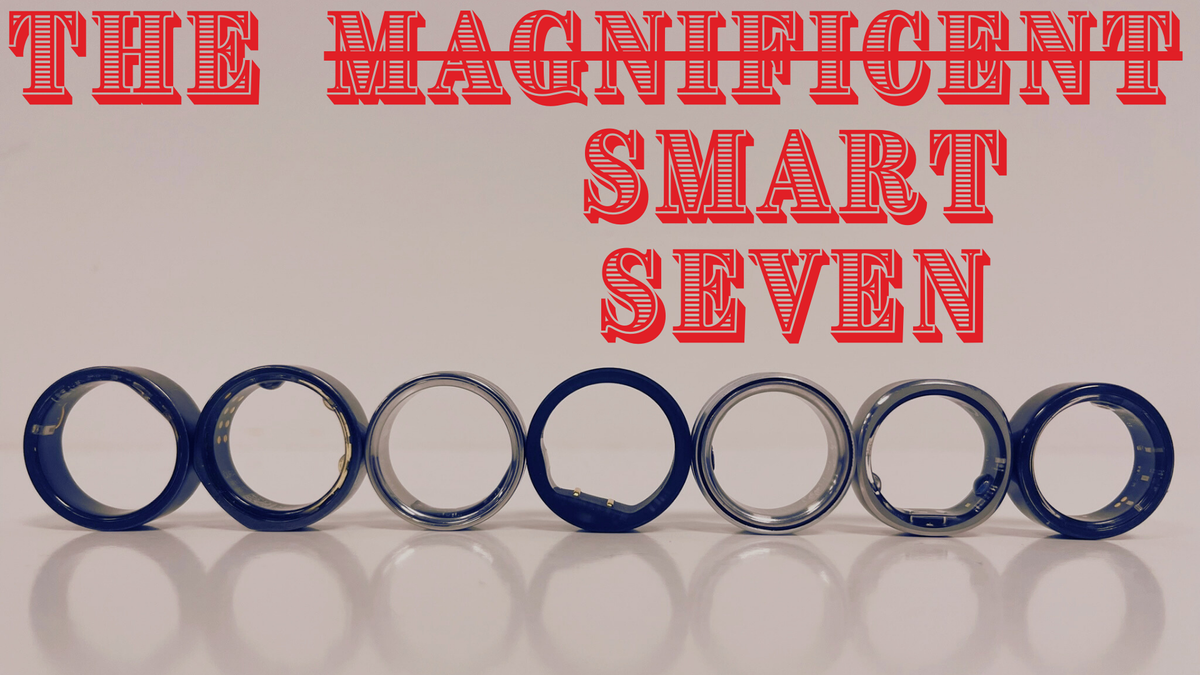
About a year ago I published an article comparing 4 smart rings and what they offer over the 24 hours:
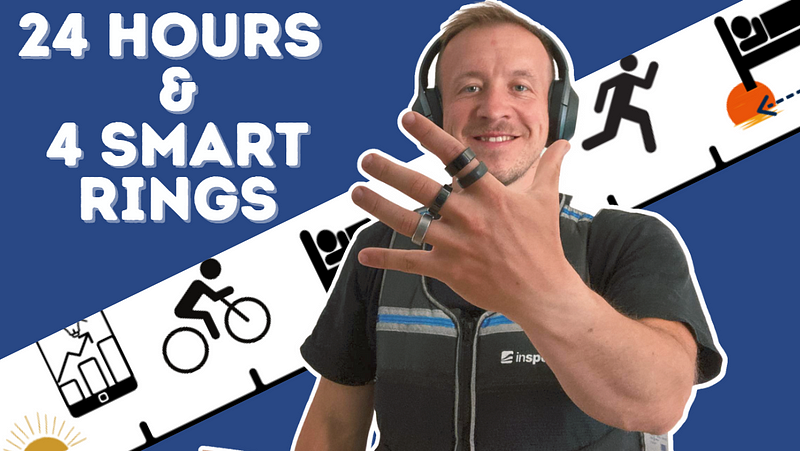
Consider this as a second part - 7 M̶A̶G̶N̶I̶F̶I̶C̶E̶N̶T̶ SMART rings.
I thought (again) about how to show you all the smart rings in daily use. I came to the conclusion that the most illustrative way would be to wear all 7 rings at the same time - this time for a few days - and compare what data the applications of these rings provide.
The second major part of this paper will be an attempt to compare the quality of the measured data. An attempt because I am not able to create exactly the same conditions for all the rings (see caveat below for more).
📐 However, I do know how to choose the right size so that the rings fit well, which is crucial for their optical sensors. I also chose the rings knowing that I would be testing them at the same time (e.g. with RingConn I was aiming for the ring finger, etc).
📆I used the rings for a couple of days. It would be better to wear them for, say, a month and show longer term trends (but I will partly do that too). But my intention now is mainly to show the general capabilities of the rings, their applications, data, weaknesses and unique functionalities.
In this article, we'll first take a look at which 7 rings will be competing in the same ring 🥊, what we'll be watching and how we'll be validating it.
So let's get to it 💥
Who's Who
Let's first introduce our contestants:
- 💍 Oura Ring Gen3 – An experienced veteran from Finland, tried and tested in many studies, reviews, and tests. #️⃣oura3
- 💍 Ultrahuman Air – A lightweight Indian competitor with a passion for biohacking. #️⃣ultrahuman
- 💍 RingConn Smart Ring – A modest but very diligent Chinese contestant with a penchant for graphs. #️⃣ringconn
- 💍 Circular Slim – The French representative, who has faced many challenges but is now ready to showcase its unique strengths. #️⃣circular
- 💍 Nova Ring and 💍 EQ R3 – Two representatives from the "Chinese clones" league. Sometimes they surprise, sometimes they disappoint. #️⃣clones
- 💍 Aizo Ring – A Chinese newcomer in the competition, distinguished by its scrolling ability and potential to shine.
Reference Devices 🎯
As reference devices (understand: referees) for comparing data quality, I chose the following:
- 🧠 Frenz Brainband – currently the best home device for measuring sleep metrics,
- ❤️ Chest strap (for HR and HRV) – used for workouts and night measurements,
- 💍 Oura Ring – one of the participants, but also a market leader with data quality validated by many entities.
Unfortunately, it's not currently possible to obtain raw data from all devices for thorough comparison. In most cases, we must rely on visual comparison of graphs (e.g., hypnograms, HR curves, etc.), key metric figures, and similar data representations.
Disciplines
What are the competition categories? They include:
- 🌅 Morning Insights
- 🚴♂️ Activity: Cycling
- 💓 HR & HRV
- 🌙 Sleep Stages
- 🔋 Battery Life
- ⛸️ Free Ride: Highlighting the unique functionality of each ring
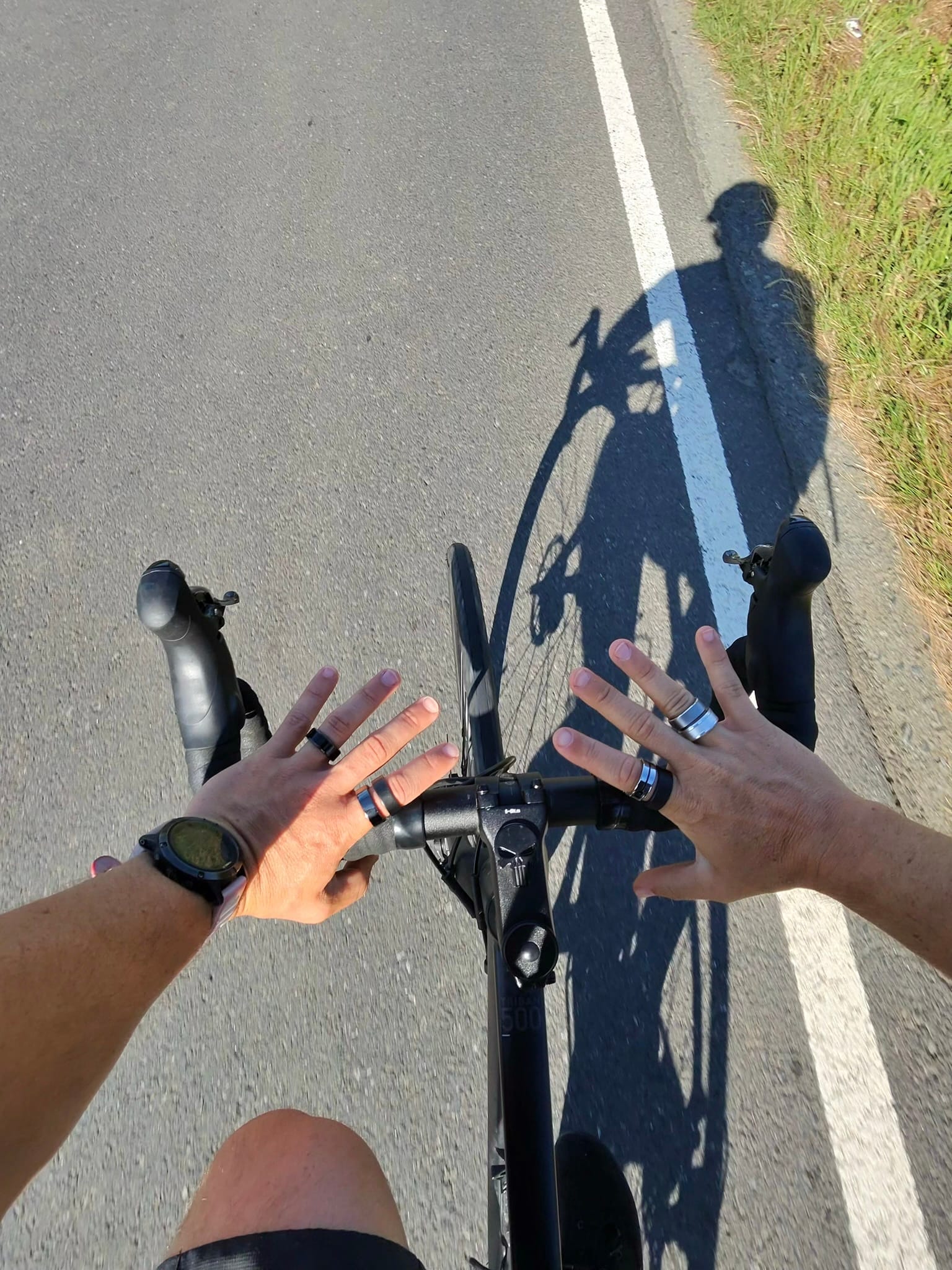

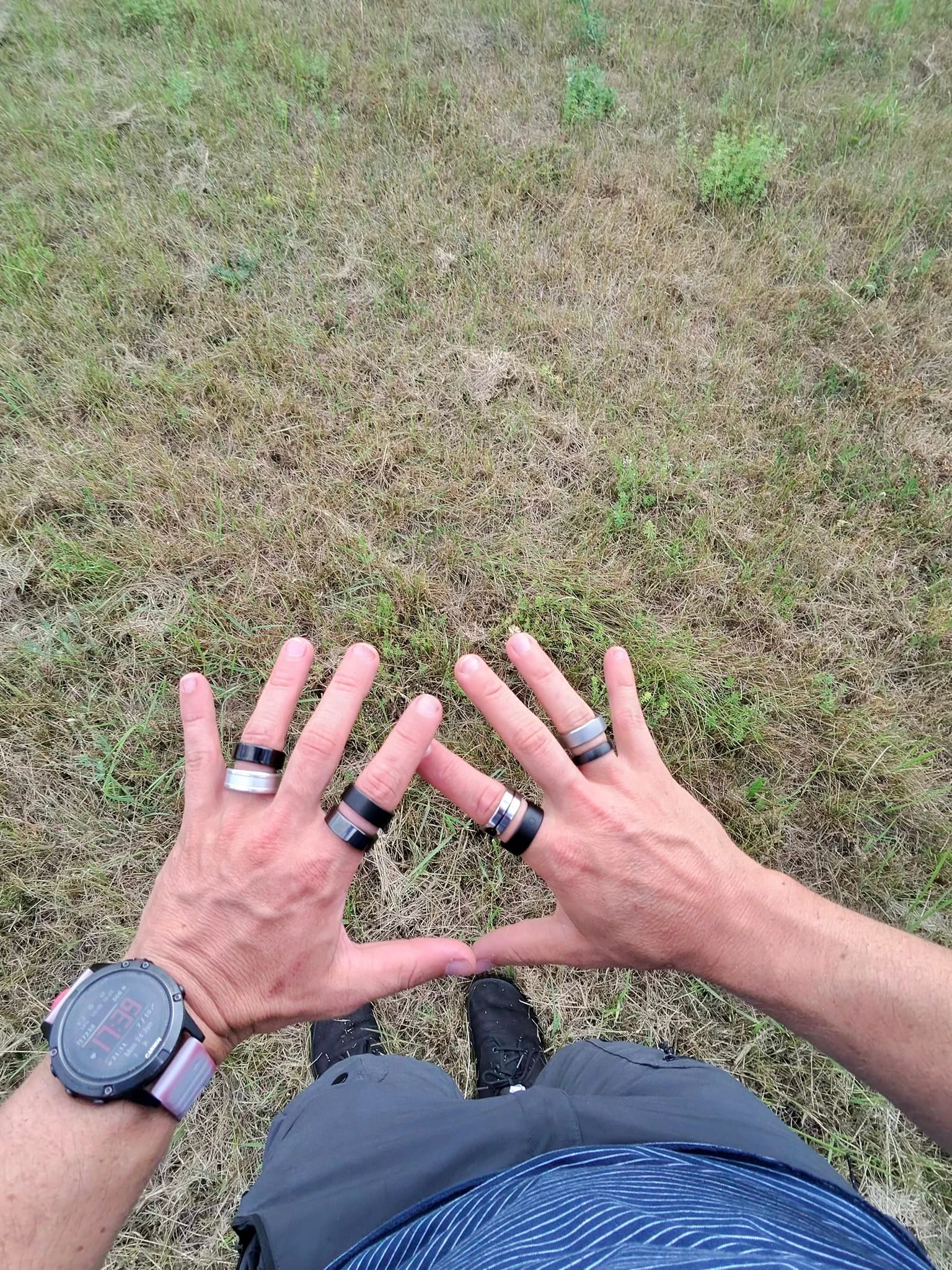
I didn't look like an oddball at all during the testing process :)
🌅Morning Insights
The morning is generally the time to check for recommendations from the ring and mobile app after synchronization. These recommendations are typically based on data from previous days and nights. We'll address the quality of sleep data later.
So, what did the rings recommend for the chosen day?
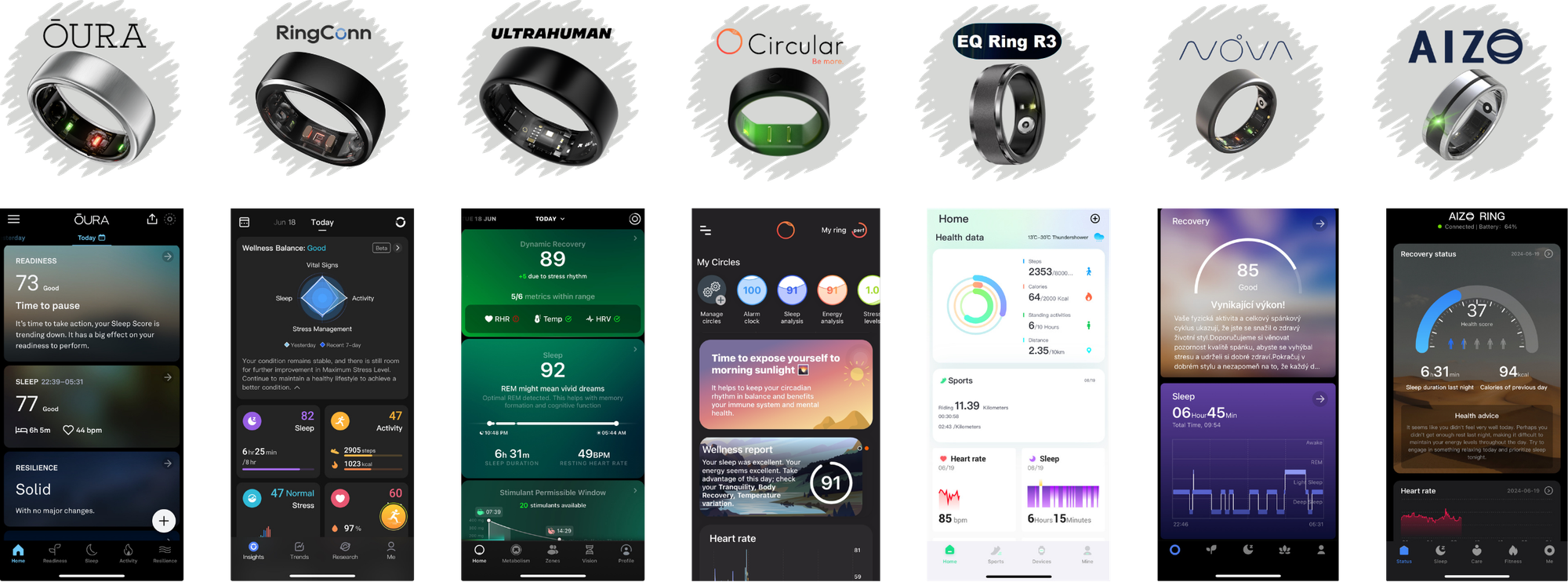
Let's break it down 🔍
- Oura – The leader in this category, offering consistently excellent recommendations based on Readiness. It often accurately identifies the cause of poor sleep and can predict impending illnesses.
- RingConn – Despite solid measurements, daily recommendations are its weakest area. However, there is noticeable progress, such as the new Wellness Balance feature.
- Ultrahuman – Recently revised its approach, now focusing on a Dynamic Score that changes throughout the day based on six contributors.
- Circular – Introduced a Wellness report with a brief AI-generated summary. The recommendations, though, remain quite general.
- EQ R3 – Provides no daily recommendations.
- Nova Ring – Underwent a significant redesign and now includes AI-generated recommendations summarizing activity and sleep with some general advice.
- Aizo Ring – Features "Health Advice," but it often incorrectly suggests feeling unwell, possibly capturing an existential sentiment akin to Kundera's "unbearable lightness of being." 🙃
🚴 Activity: Cycling
This year, many rings have implemented workout/activity functionality. You can initiate activity tracking from the app, choosing from various types of activities and sports. The ring frequently monitors heart rate, and if it makes sense and you grant permission, the app also records the GPS route via your mobile device.
Oura is unique in also offering AAD (Automatic Activity Detection).

All the rings support cycling activity, which I chose because hands remain static while cycling, creating ideal conditions for accurate measurement by optical sensors. We'll compare the heart rate data from the rings against a chest strap using the Garmin environment:

If you closely examine the image above, we can conclude the following:
- Smart rings, by design, cannot match the heart rate accuracy of chest straps or smartwatches. Key factors for accurate optical sensor measurements are snug fit and static position, which are more reliably achieved with watches/bracelets.
Despite this, smart rings can still provide approximate heart load measurements.
- The first four rings perform reasonably well.
- Ultrahuman has shown significant progress (for long time it was very inaccurate), although its functionality is still in beta.
- However, Chinese clones and Aizo disappointed, either failing to record data or doing so poorly.
For further testing, I chose interval training, expecting to see five peaks over 170 bpm on the HR curve.

The results were similar to the previous test: the clones failed (Aizo gave up at the start), while the first four rings performed decently. Surprisingly, Oura underperformed, whereas Ultrahuman AIR performed very well once again.
💓 HR & HRV
Heart rate (HR) and heart rate variability (HRV) is measured at night, an ideal time for comparison as hands are less active and both metrics are highly informative during sleep, indicating how well the body is recovering.
For the test, I wore a chest strap and used the HRV+ app during the night. The chest strap begins measuring immediately, while rings start calculating HR and HRV after detecting sleep. I fall asleep quickly, so this timing works well ;-)
Specifically, we'll look at the average HR (highlighted in yellow 🟡) and average HRV (highlighted in red 🔴) throughout the night.

Notes:
- It's crucial to distinguish between Resting HR (lowest heart rate during the night) and average HR. For instance, the EQ R3 doesn't provide average nighttime HR or HRV.
- All rings calculate HRV using RMSSD.
- Ultrahuman calculates HRV differently, excluding the AWAKE phase, leading to differences from the reference chest strap.
- Gaps in HR readings can occur due to various factors (excessive movement, dirty sensors, loose ring, etc.).
- I conducted measurements over several nights to share the trend with you.
Trend 💓 HR & HRV
So I wore a chest strap and seven rings over six nights to provide a more informative trend.
For HR, observe how closely the rings' curves align with the reference red curve (chest strap via HRV+ app):
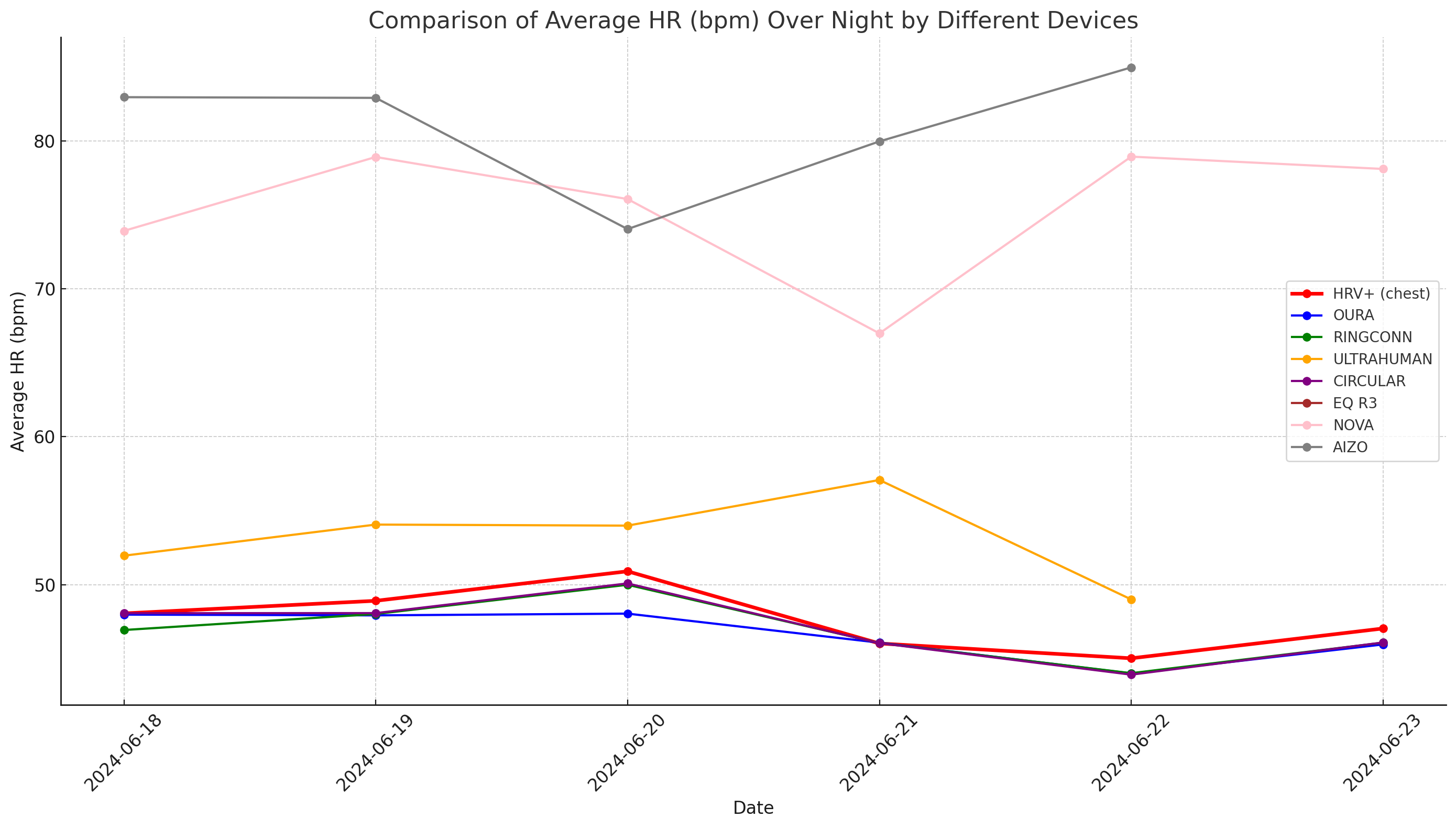
- AIZO: They say they expecting a significant PPG software update.
- Ultrahuman: Seems to overestimate HR, likely due to excluding AWAKE phases from calculations, making accuracy validation difficult.
- Oura, RingConn, Circular: Excellent performance, with differences from the reference maxing out at ±1 bpm.
HRV: The situation is very similar for HRV trends.
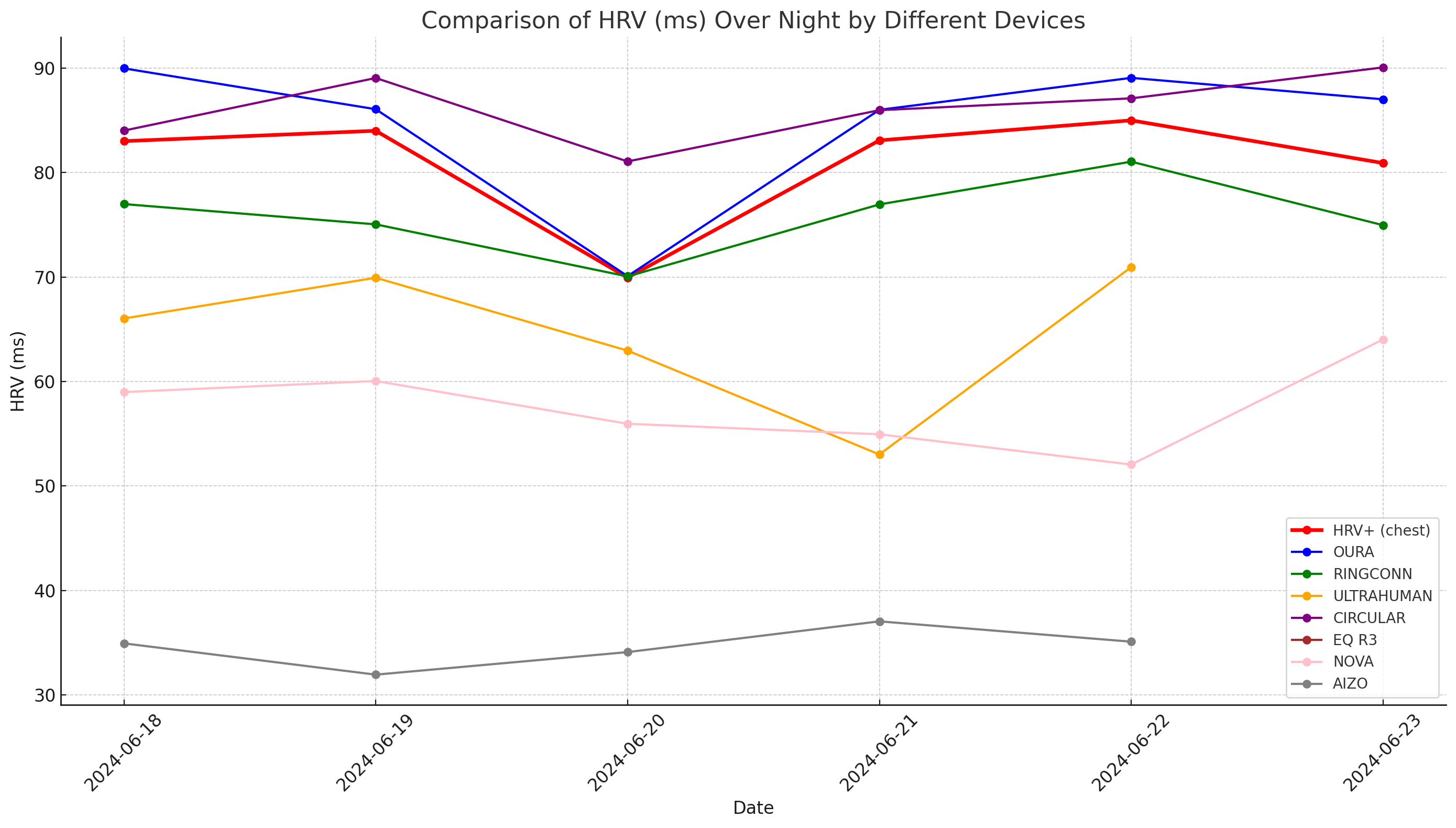
- EQ R3: No data available.
- Ultrahuman: Deviates due to different calculation methods.
- Oura & RingConn: Excellent alignment with the reference trend.
- Circular: Very good alignment.
🛏️ Sleep Stages
The more I delve into wearables (and sleep), the more I realize how difficult it is to determine sleep stages accurately. Most rings can roughly estimate the beginning and end of sleep, but everything in between is somewhat alchemical 🧪.
Currently, it's technically impossible for me to download raw data from the devices for a deeper analysis. Therefore, we have to rely on comparing one night's data from the rings with the reference FRENZ Brainband:
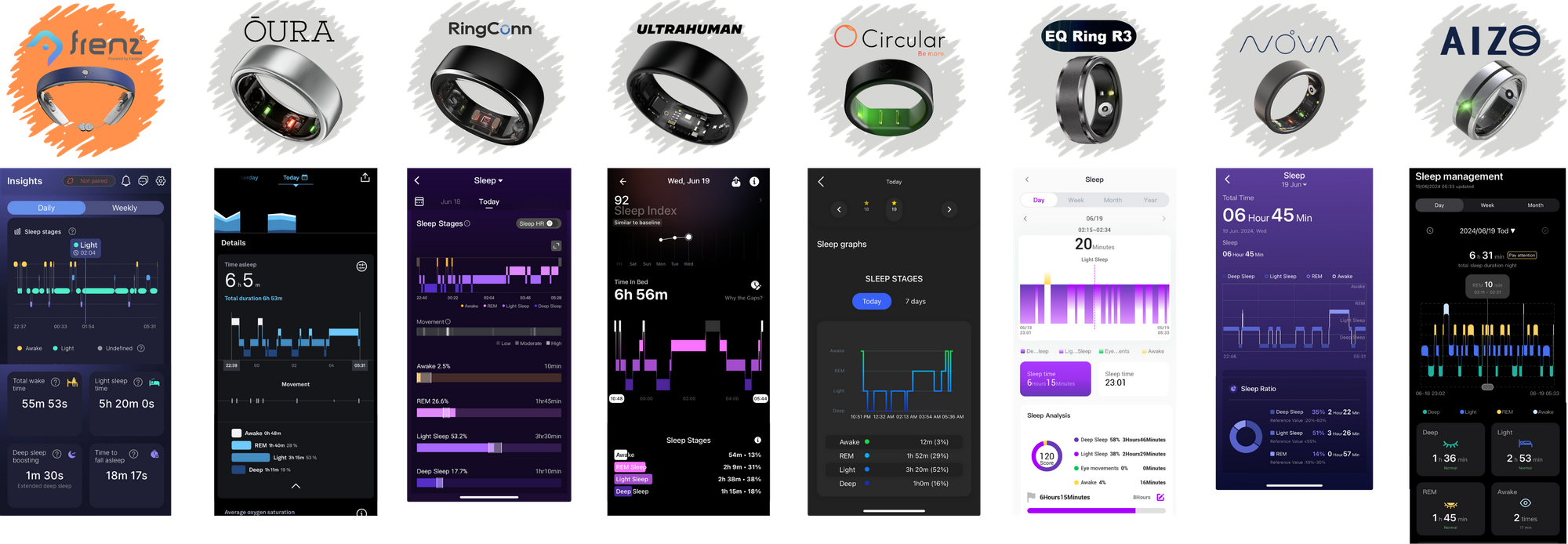
From my long-term experience, I trust the Oura ring, which has improved its algorithm over time. I've also noticed progress in RingConn and Ultrahuman, while Circular promises updates soon. The clones and Aizo are not worth mentioning.
🔋 Battery
It's fascinating how long the tiny batteries in smart rings can last. Three main factors affect battery performance:
- Age of the ring (shown as "AGE" in months in the infographic).
- Ring firmware – each update can change battery life.
- Usage and care – such as using workout features or going to the sauna can drain the battery.
All rings were charged on Tuesday morning. The infographic below shows their status on Friday morning:
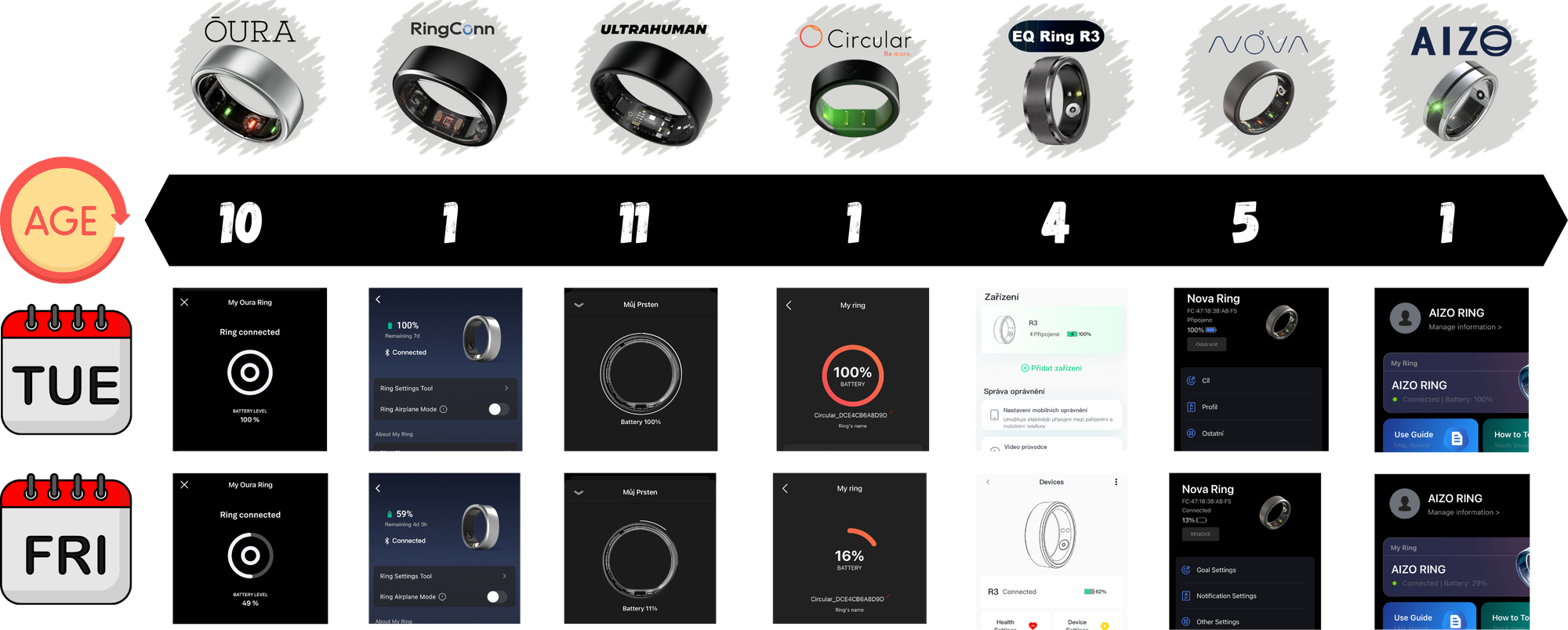
Here's the situation:
- All three rings lasted 3 days and 3 nights.
- Ultrahuman, Circular, Nova, and AIZO needed recharging after 3 days.
- RingConn has the best battery life, followed by Oura.
- Circular improved with the latest update and is the only ring where you can influence battery life with two modes: Performance and Eco.
⛸️ Free Ride
I select smart rings for testing based on their unique functionalities or features. Here are standout aspects for each ring:
Oura – Versatile Reliability ⚖️
Though this may not sound unique, Oura is consistently stable, reliable, and versatile. Its continuous development maintains established trends (with the exception of the sleep algorithm update) and adds new metrics (Stress, VO2Max, Cardiovascular Health, Symptom Radar, etc.).
Ultrahuman – Biohacking Features 🦾
Ultrahuman is a software innovator and biohacker. The app is frequently updated, leading to optimizations and visual changes almost daily. It reorganizes metrics and enhances performance. Additionally, the Ultrahuman app serves as a hub for multiple devices, creating a comprehensive platform.
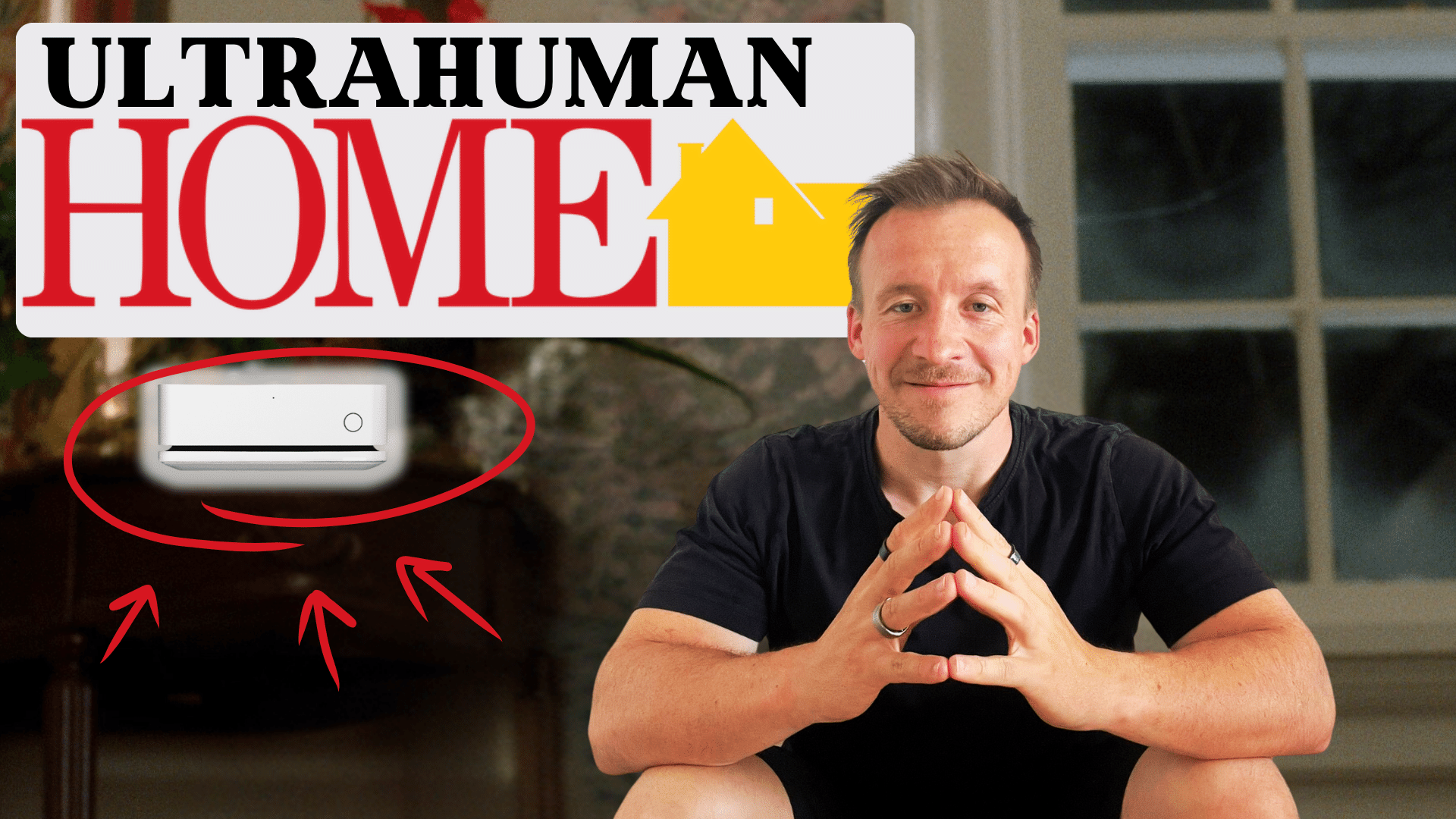
RingConn – Comprehensive Data Collection 📊
RingConn is the king of all charts. For data enthusiasts, RingConn is a treasure trove. You can even share your data with others, such as family members.
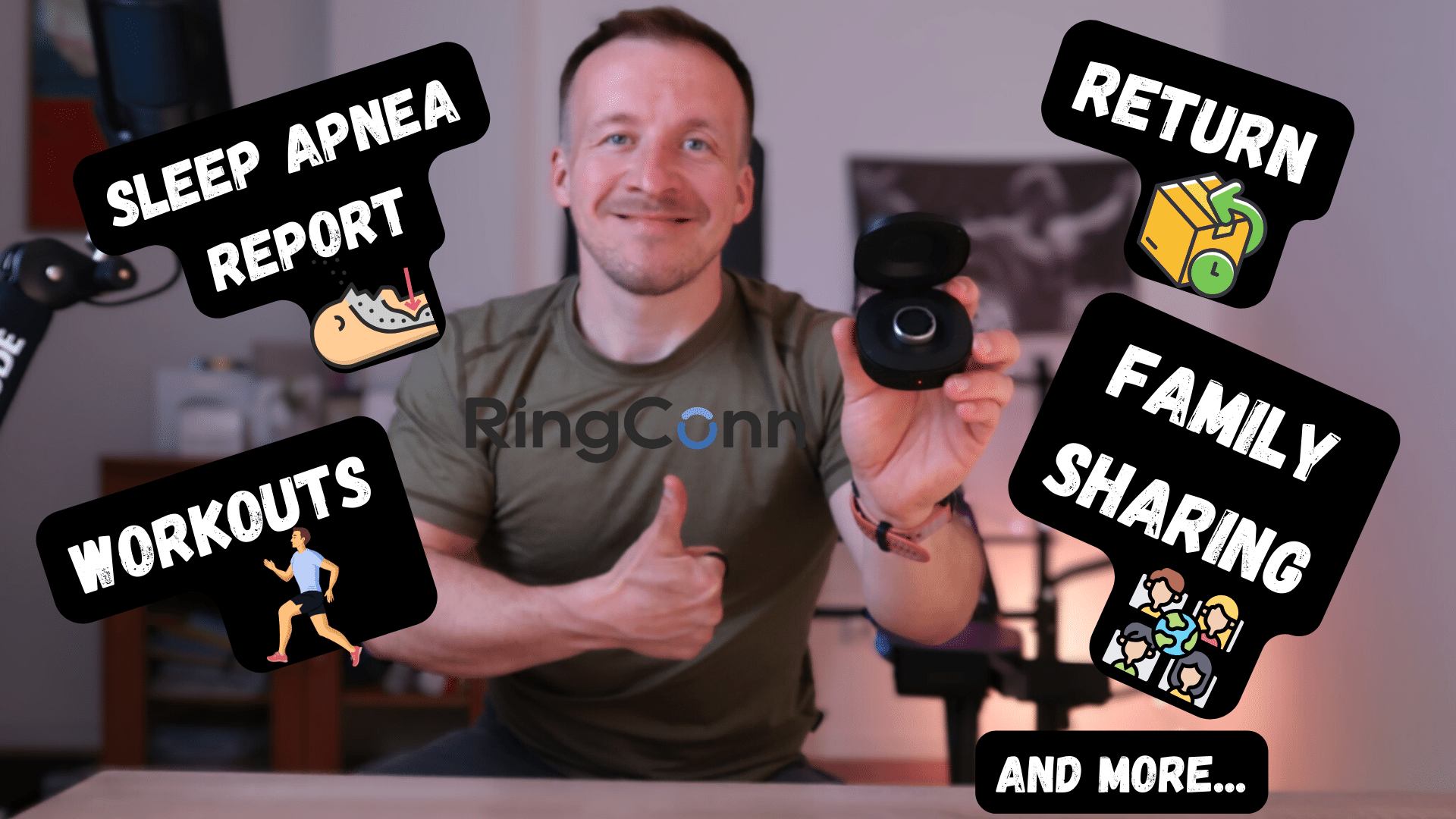
Circular – Unique Vibration Feature 📳
The only ring that can vibrate. It functions as an alarm, alerts for low/high heart rates, medication reminders, and more. Unfortunately, it does not notify for calls and messages.
Clones – Affordability 🏷️
EQ R3 and Nova stand out for their low prices (about 1500-2500 Kč). If I had to choose, I'd go with the Nova ring, which recently updated its app and features some AI recommendations.
AIZO – Touch Functionality 👈
The Aizo Ring is a newcomer to my portfolio, and I haven't published any solo content on it yet. Its notable feature is the touch surface.
The Aizo Ring also features an LED for visual notifications. Incidentally, the Aizo Ring is produced by the same company as the upcoming Ringo Ring.
Conclusion
What should we take away today? The Oura Ring remains the most versatile and accurate but also the most expensive (especially with the subscription).
Competitors like RingConn and Ultrahuman are very respectable alternatives. Circular, with the new Slim v2024 version, is also noteworthy.
Clones (Nova, EQ R3) are more like toys without significant biofeedback value. AIZO has unique features but needs to improve data accuracy.
The smart ring market is vibrant. Expect another test in the future. What disciplines would you like to see next time?
🛒 Shopping Deals
Get a discount through the links below, and we might earn a small commission. Maybe.




